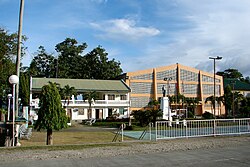Duero, Bohol
Appearance
Duero | |
|---|---|
 Duero | |
 Map of Bohol with Duero highlighted | |
| Country | Philippines |
| Region | Central Visayas (Region VII) |
| Province | Bohol |
| District | 3rd district of Bohol |
| Founded | 1862 |
| Barangay | 21 (see § Barangays) |
| Government | |
| • Type | Sangguniang Bayan |
| • mayor of Duero[*] | Conrada Amparo (LP) |
| • Vice mayor of Duero | Emma Bajade |
| • Municipal Council | Members |
| Area | |
• Total | 97.30 km2 (37.57 sq mi) |
| Population (2020 census)[3] | |
• Total | 18,861 |
| • Density | 190/km2 (500/sq mi) |
| • Voter (2022)[4] | 14,109 |
| • Language | Boholano dialect Cebuano Eskayan Tagalog |
| Time zone | UTC+8 (PST) |
| ZIP code | 6309 |
| IDD : area code | +63 (0)38 |
| Income class | 4th class |
| PSGC | 071221000 |
Duero is a [[Template:PH plural of the Philippines#Income classification|4th municipal income class municipality]] in the province of Bohol, Philippines. According to the 2020 census, it has a population of 18,861.[3] Template:PH electorate It may have been named after the Douro (Duero) in the Iberian peninsula.
Roman Catholicism was introduced to the town in 1860 by a Spanish priest. Duero was established as a municipality two years later, and a convent was constructed in 1868.[5]
Barangays
Duero comprises 21 barangays:
| PSGC | Name | Population | ±% p.a. | |
|---|---|---|---|---|
| (2015)[6] | (2010)[7] | |||
| 071221001 | Alejawan | 773 | 801 | −0.68% |
| 071221002 | Angilan | 514 | 540 | −0.94% |
| 071221003 | Anibongan | 479 | 540 | −2.26% |
| 071221004 | Bangwalog | 1,358 | 1,340 | 0.25% |
| 071221005 | Cansuhay | 789 | 735 | 1.36% |
| 071221006 | Danao | 646 | 688 | −1.19% |
| 071221007 | Duay | 482 | 390 | 4.12% |
| 071221008 | Guinsularan | 1,689 | 1,736 | −0.52% |
| 071221016 | Imelda | 603 | 615 | −0.37% |
| 071221009 | Itum | 1,135 | 1,139 | −0.07% |
| 071221010 | Langkis | 980 | 1,002 | −0.42% |
| 071221011 | Lobogon | 1,338 | 1,329 | 0.13% |
| 071221012 | Madua Norte | 515 | 475 | 1.55% |
| 071221013 | Madua Sur | 731 | 699 | 0.86% |
| 071221014 | Mambool | 607 | 556 | 1.68% |
| 071221015 | Mawi | 523 | 518 | 0.18% |
| 071221016 | Payao | 639 | 598 | 1.27% |
| 071221017 | San Antonio (Pob.) | 1,181 | 1,211 | −0.48% |
| 071221018 | San Isidro | 816 | 809 | 0.16% |
| 071221020 | San Pedro | 1,467 | 1,334 | 1.83% |
| 071221021 | Taytay | 611 | 525 | 2.93% |
| TOTAL | 17,876 | 17,580 | 0.32% | |
Demographics
|
| ||||||||||||||||||||||||
| Source: Philippine Statistics Office[6][7][8] | |||||||||||||||||||||||||
Gallery
-
Duero town hall
-
Public market
-
Church
References
- ^ Municipality of Duero | (DILG)
- ^ "Municipal: Duero, Bohol". PSGC Interactive. Quezon City, Philippines: Philippine Statistics Authority. Retrieved 8 January 2016.
- ^ a b Census of Population (2020). "Region VII (Central Visayas)". Total Population by Province, City, Municipality and Barangay. Philippine Statistics Authority. Retrieved 8 July 2021.
- ^ "Number of Registered Voters by Sex : 2019 National and Local Elections" (PDF). Commission on Elections. 2019.
- ^ "Municipality of Duero". Retrieved 30 January 2015.
- ^ a b Census of Population (2015). "Region VII (Central Visayas)". Total Population by Province, City, Municipality and Barangay. Philippine Statistics Authority. Retrieved 20 June 2016.
- ^ a b Census of Population and Housing (2010). "Region VII (Central Visayas)" (PDF). Total Population by Province, City, Municipality and Barangay. National Statistics Office. Retrieved 29 June 2016.
- ^ Censuses of Population (1903–2007). "Region VII (Central Visayas)". Table 1. Population Enumerated in Various Censuses by Province/Highly Urbanized City: 1903 to 2007. National Statistics Office.
External links
Wikimedia Commons has media related to Duero.



